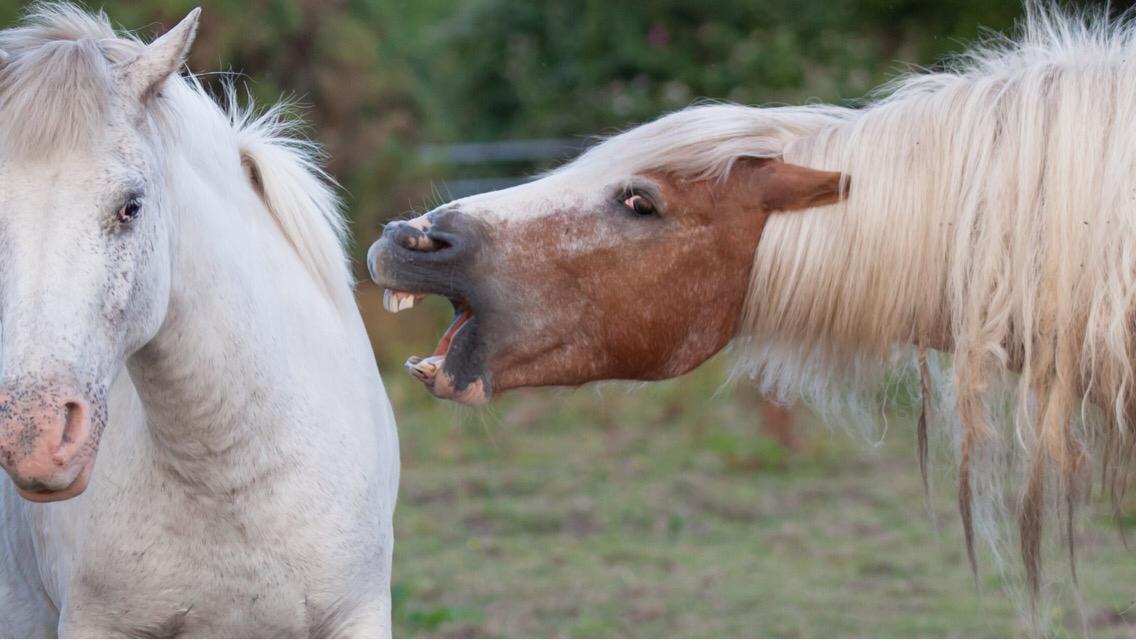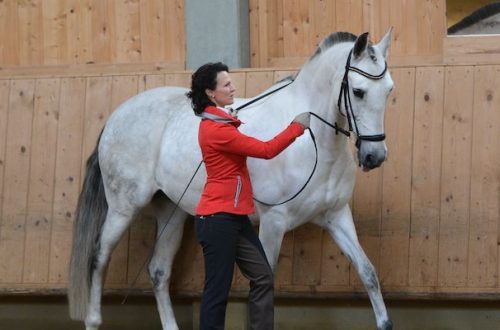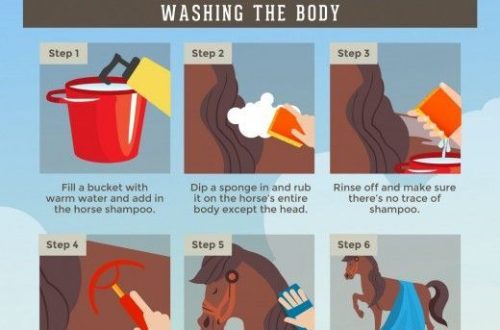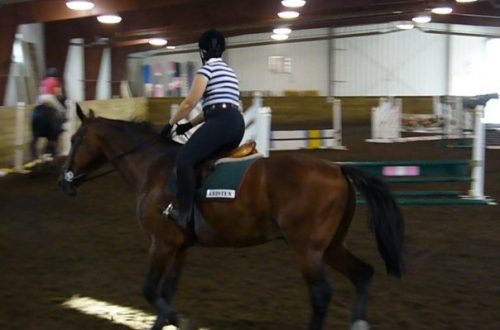
How to deal with an aggressive horse?
How to deal with an aggressive horse?
Aggressive horses can be a danger to anyone around them, whether they are people, other horses, or animals. General safety should not depend on inappropriate behavior by the horse, so it is necessary to select methods that force him to retreat from his usual display of aggression.
Over the decades of my practice, I have dealt with many cases of unpleasant behavior on the part of horses. Many problems are solved quite simply – just put the horse in a position where he fails when he shows his unwanted behavior. So, if a horse pinches or bites while saddling, I can just put my elbow out when he turns his head in my direction. If your horse has a habit of banging on the door of the stall in the pre-dinner hours, you can put on unpleasant music at such times, and this will quickly teach the horse to behave calmly.
It’s all about creativity. You ask yourself, “What else can I do to make the horse uncomfortable or difficult to show his aggression?” It is important to be ready and have a plan so as not to be unarmed at the moment when the horse begins to behave inappropriately. You must be able to create a situation in which the horse would simply “hit a brick wall” – all his attempts to misbehave would lead to discomfort. And it’s not about beating horses, it’s about making them fail.
Black and white zones
I build my communication with horses on the principle of a black and white zone. When I first encounter a new horse, I try to create a pleasant and calm environment for him. I I’ve done research and can almost instantly spot a point on a horse’s body that will make it “melt”. The eyes, the tongue, the place under the lower jaw, the nose, the withers are the places that I can manipulate to win over the horse. Most horses have never had their eyes rubbed and can be made to melt by simply scratching the area around the eyes. Few horses have ever had a finger in their nose. Having correctly determined the desired point, you will literally put the horse on its knees with pleasure. Let’s add a soothing voice. This is the white zone!
But there is also the opposite end of the scale – the black zone. It does not please anyone, especially the horse. The sounds accompanying this uncomfortable zone are harsh, guttural. I use the “shhhhhhhhhhhhh” sound with increasing volume, noise, or a deep guttural husky sound. The physical impact can range from being reined in with a lead or rope that you use to intercept the horse’s jaw, to an unpleasant tune played by a radio or a walkman. Discomfort should correspond to undesirable behavior. The most important thing is that it all makes sense to the horse, that the last thing he wants to do is get into the black zone because of his unwanted behavior. The moment the unwanted behavior stops, the black zone also disappears.
We read the horse
The ability to easily read a horse is not given to everyone, but it is very important to understand the difference between fear, aggression, stubbornness and a confused state of the horse. Too often we are right in the middle of what I call a gray area. We don’t really know what we want, but for some reason we think that the horse will understand us correctly. ,And now, if the horse finally understands what we need, we do not reward him and do not let him know that he did everything right. All efforts end in disappointment…
When you ask a horse for something, be sure that you know how to ask and what you want in return so that you can reward the horse in time.
This is how it should be the order of your communication: request -> panticipation —> receiving a response from the horse —> easing —> promotion.
Softening is also a reward, but if you want to speed up the learning process, stroke the horse lightly, accompanying this with a gentle voice. Praise will speed up the learning process by 60%!
Let’s get back to reading the animal.
Fear implies a frightened look (you can even see the sclera) and an overly alert behavior – another second and the horse will flee.
The frozen state is the shutdown, the horse is testing and gaining courage. A frozen horse is likely to have experienced pain or pressure frequently and does not want to experience the sensation again. Perhaps the riders gave her conflicting commands, and she just “closed up.”
Aggressive horses are bold and assertive, they are ready to go against the whole world. They managed to intimidate a person and they learned to win. Such horses are extremely dangerous, and their aggression must be dealt with, otherwise the situation will worsen. Ears turned back and arched neck are typical signs of an aggressive horse.
I would like to offer you some examples of working with aggressive horses. Keep in mind that no approach is perfect and success depends on time and rider confidence. A half-serious attempt will lead to half success. You have to imagine how and what will happen. Your attempts should bring the expected results.
A few years ago I dealt with a mare that was aggressive when eating. She began to lay her ears back. We put a couple of patches of hay in the middle of the arena and she went into it with the same menacing look. My assistant – a stick with a rustling bag on the end – was prepared in advance. When the horse entered, I approached him with a stick, rustling the plastic loudly. She stepped back about ten paces and stood up with her neck held high and the whites of her eyes popping out as if to say, “Wow, I’ve met a rival.” When I stepped back from the hay, the mare came up again, still with her ears stuffed up, her head down and her neck arched. And again she came across a brick wall, which was accompanied by a loud noise and hissing shhhhhhhhhhhhhhhh. Again she stepped back, her eyes wide. When I retreated for the third time, she politely asked me to come and eat, which, of course, she was allowed …
Another aggressive horse had a habit of kicking horses passing by. I mounted and called for an assistant. When he rode up, my horse laid his ears back and prepared to strike, but at that moment the evening ceased to be languid. I started making noises (shhhhhhhhhhh), moving the reins up and down, fidgeting in the saddle and pounding my feet on her sides. The horse ran into a brick wall. When her ears returned to their normal position, I also calmed down in the saddle and stroked her, gently encouraging the horse with my voice. I gave the horse a couple of minutes to comprehend what had happened, and then again asked the assistant to drive up to me. I was prepared for the reaction of the horse. If her ears look forward and she calmly lets another horse pass, then we do not leave the white zone. If the ears are just beginning to fold back, I immediately turn on the black one. Thanks to precise timing and a well-developed plan, the problem was solved in a very short time.
A few years ago, a friend of mine complained to me about her horse, which kicked when entering the levada. She had to dodge to avoid getting hit. I told her that I always work with the horse for concessions at the beginning and at the end of our communication. She took her bay gelding out to pasture, relaxed and calmed him, and only then partially removed the halter. Holding his strap around the horse’s neck, she asked him to tilt her down, and then, having received what she wanted, she let him go (the horse was soft and yielded to pressure). He, in turn, did not try to hit, but remained nearby. Then my friend even had to push him away when she closed the gate.
In a round barrel, a roan gelding comes at me, showing aggression and demanding that I come out. I force him to back off by throwing the rope in his face with a guttural sound. I move him along the side of the barrel, forcing him to change directions, turning his back to me. When he seemed to relent and show respect then, and only then did I let him turn his head towards me. Then I go up to him and teach him that there is an easy way to do something (white zone) and a difficult way (black zone) that he chose so badly.
Punishment if needed
It happens that the horse even becomes belligerent, and then punishment is indispensable … Unfortunately, we too often allow behavior that turns our horse into a monster. Keep in mind that the most unwanted behavior is unintentionally caused by a person.
We always train our horses in both positive and negative ways, which is where the problems start. If we do not identify the beginnings of negative behavior early on, we will need more drastic measures to eliminate it later on.
The most effective discipline tool I have found for myself is a stern rein back followed by a loud noise (shhhhhhhhhhhhhhh). Take the lead under the chin and pull back hard, an action that will effectively get the attention of most horses. After ten or fifteen steps back, I allow the horse to rest for a couple of minutes. Most horses will stare at me with wide eyes, then lower their heads and lick their lips, realizing they were doing something wrong. After that, I usually release the pressure and calm the horse, we return to the white zone. I tell the horse by my actions: “There is an easy way to make your antics difficult. The choice is yours”.
Some horses seem to need to taste us or push our buttons. For some horses, this seems to be becoming a game we can’t let them win. They must run into a brick wall and take the easier path, not the one that creates problems.
For example, stubborn horses may simply stop and refuse to go forward. When this happens on the ground, I hold the lead firmly with one hand, and with the other I begin to hit the stretched lead. This action irritates the horse, and eventually he takes a step forward – I immediately stop pulling the lead. I allow the horse to process the situation for a bit and then ask him to move forward again. If the horse refuses to go again, he will receive the same irritating action in response. Pretty quickly, most horses make the right choice and start behaving like a good boy.
Horses that refuse to move forward under the saddle also face irritation. Only now I tap my leg against the side of the horse, forcing him to move away from the pressure. I also turn the horse’s head and shift my weight into the side of the walk, which encourages the horse to step under the changed balance. Moving forward removes the black zone. As I move forward, my body sets a rhythm that says, “Now we’re going somewhere.” If the horse gets up again, he will meet the same response, only this time I can force him to give in to the pressure from one side to the other, until he finally understands that it is easier to go forward than just get up and refuse to go.
7 Steps to Confront an Aggressive Horse
1. Formulate a strategic plan that will allow you to build a brick wall in front of the horse when unwanted behavior appears.
2. Get your auxiliary tools ready. “Pistol at the ready.”
3. Create a situation for the desired behavior.
4. Act quickly and without remorse.
5. Allow the horse to become aware of the “lesson”. Give her time to digest her mistake.
6. Show the horse the other side of the coin, the white zone. It must be her choice.
7. Always be honest. Honesty and toughness are the words to remember.
In conclusion
Working with aggressive horses is serious business. All horses check and test people. Don’t take it to heart. Acknowledge the problem and then take the time to understand what it will take to help the horse make the right decision. The more time you spend at the beginning, the less you will spend at the end, so feel free to step back and think about your strategy. Challenge yourself to creatively help your horse. But, acting on your own, try to be objective – there are situations when you should not neglect professional help. Don’t think about your ego, think about the result!
Frank Bell (source); translation by Valeria Smirnova.





